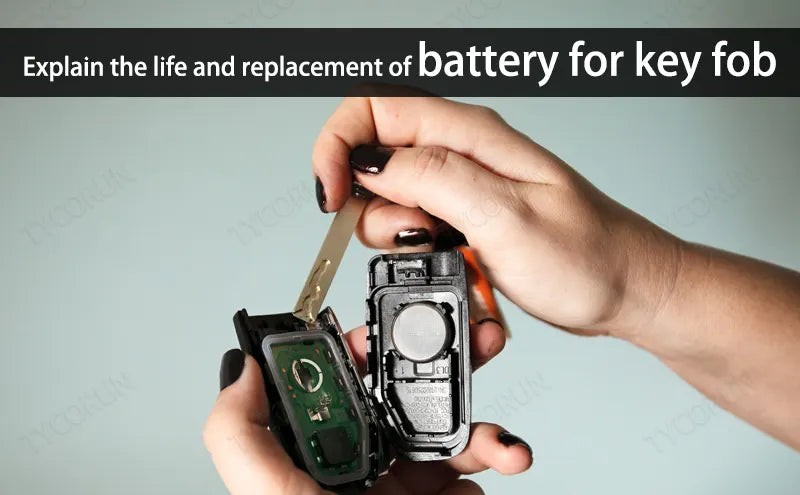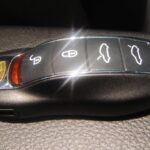In our fast-paced, technologically driven world, the convenience of modern car features cannot be overstated. Keyless entry and remote start systems, powered by your key fob, have become indispensable. Gone are the days of fumbling with traditional keys in the rain or dark. However, this convenience relies on a small but crucial component: the key fob battery. Like any battery, the one in your key fob has a limited lifespan. Understanding how long a battery lasts in a key fob, recognizing the signs of a dying battery, and knowing how to address it are essential for every car owner. Imagine heading out, only to find your key fob unresponsive – a frustrating scenario easily avoided with a little knowledge and proactive maintenance.
What is a Key Fob Battery?
A key fob battery is essentially the power source for your car’s remote control. It’s a small, electronic transmitter that sends signals to your vehicle, enabling you to lock and unlock doors, open the trunk, activate the panic alarm, and sometimes even start the engine remotely. Think of it as a miniaturized radio transmitter, similar in concept to a TV remote, but specifically programmed to communicate with your car.
Most key fobs are powered by lithium button batteries. These batteries are favored for their compact size, long shelf life, and stable power output, which are crucial for the consistent performance of your key fob. To ensure optimal performance and longevity, it’s advisable to keep your key fob and spare batteries in a dry environment. Moisture can lead to corrosion, potentially damaging the battery and the key fob’s internal circuitry.
Key Fob Battery Lifespan: How Long Do They Really Last?
Under typical usage conditions, the battery in a key fob is expected to last anywhere from 2 to 3 years. This is a general guideline, and the actual lifespan can fluctuate based on several factors. It’s important to note that there’s no precise expiration date stamped on your key fob battery. The longevity is primarily determined by usage frequency, the specific car model, and even environmental factors.
Some car owners might find their key fob battery lasting only a year, while others might experience 5 or even 10 years of service from the original battery. This variability highlights the impact of individual usage habits and other influencing factors.
Factors Affecting Key Fob Battery Life
- Usage Frequency: The more frequently you use your key fob – pressing buttons daily to lock/unlock doors, activate remote start, etc. – the faster the battery will drain. Each button press initiates a signal transmission, consuming a small amount of battery power.
- Environmental Factors: Extreme temperatures, both hot and cold, can impact battery performance and lifespan. Excessive heat can accelerate battery degradation, while extreme cold can temporarily reduce battery output. Avoid leaving your key fob in direct sunlight or freezing conditions for extended periods.
- Battery Quality: The quality of the battery itself plays a role. Opting for reputable brands of button batteries can often ensure a longer and more reliable lifespan compared to generic or lower-quality alternatives.
- Car Model and Key Fob Design: Different car models and key fob designs may have varying power consumption characteristics. Some advanced key fobs with features like proximity sensors or LCD screens might draw slightly more power than basic models, potentially impacting battery life.
- Proximity and Signal Strength: Constantly trying to operate the key fob from a long distance or in areas with signal interference can strain the battery as it works harder to transmit a signal.
Signs Your Key Fob Battery is Dying
Being aware of the telltale signs of a weakening key fob battery can save you from unexpected lockouts or inconveniences. Recognizing these symptoms early allows for timely battery replacement, ensuring uninterrupted access and functionality.
- Reduced Range: One of the earliest indicators is a noticeable decrease in the key fob’s operating range. You might find that you need to be much closer to your car than usual for the remote to function. Where you previously could unlock your car from a considerable distance, you now need to be right next to the door handle.
- Intermittent Functionality: Another common sign is inconsistent performance. You might press a button, but nothing happens. Sometimes it works after multiple attempts, and other times it’s completely unresponsive on the first try. This sporadic behavior suggests that the battery is struggling to consistently provide enough power.
- Key Fob Indicator Light Dim or Flashing: Most key fobs have a small LED indicator light that illuminates when a button is pressed. If this light appears dimmer than usual or flashes weakly instead of a solid, bright light, it’s a strong indication of a low battery.
- Dashboard Warnings: Many modern vehicles are equipped with sophisticated monitoring systems that can detect a low key fob battery. A warning message might appear on your car’s dashboard display, specifically indicating a “low key fob battery” or similar alert. Pay attention to these warnings as they are direct indicators.
- Slow Response Time: You might observe a delay between pressing a button on your key fob and the car responding. If there’s a noticeable lag where the car takes a few seconds to react after you press a button, the battery could be weakening.
- Unusual Error Messages: In some cases, a dying key fob battery can trigger unusual error messages on your car’s display, perhaps related to the security system or keyless entry. While less common, these errors can sometimes be linked to insufficient power from the key fob.
It’s worth remembering that occasional key fob unresponsiveness could also be due to external interference, although this is less likely. For peace of mind, especially when locking your car, always double-check that the doors are securely locked before walking away, regardless of key fob behavior.
What to Do When Your Key Fob Battery Dies
Finding yourself with a dead key fob battery can be inconvenient, but it’s rarely an emergency. Fortunately, there are straightforward solutions to regain access to your vehicle and get back on the road.
-
Using the Mechanical Key: Every key fob contains a hidden mechanical key. Locate the release mechanism on your key fob (often a small button or slider). Activating this release will allow you to slide out the physical key. This mechanical key can be inserted into the traditional door lock cylinder, usually located on the driver’s side door handle. The keyhole might be concealed under a small cover that needs to be popped off.
For cars with push-button start, even with a dead key fob, you can still start the engine. There’s typically a designated “sensing area” inside the car, often on the steering column or dashboard. Place the key fob directly against this sensing area. This allows the car to detect the key’s transponder chip, even without battery power, enabling you to start the vehicle. In some cases, you might need to pry off the plastic cover around the push-button start to reveal a hidden keyhole where you can insert the mechanical key for starting.
-
Key Fob Battery Replacement: A Step-by-Step Guide: The most permanent solution is to replace the key fob battery. This is a relatively simple DIY task for most car owners and far more cost-effective than going to a dealership immediately.
- Identify Your Battery Type: Open your key fob (refer to your owner’s manual for specific instructions, or search online for your car model and “key fob battery replacement”). Once open, note the battery model number printed on the existing battery. Common types are CR2032, CR2025, and CR2016.
- Gather Your Tools and New Battery: You’ll typically need a small flathead screwdriver (often a precision screwdriver or even a butter knife will work) to gently pry open the key fob casing. Purchase the correct replacement battery (available at most drugstores, supermarkets, and battery stores).
- Open the Key Fob: Carefully use the screwdriver to open the key fob casing. Avoid excessive force to prevent damage to the plastic.
- Remove the Old Battery: Gently pry out the old battery. Note the battery orientation (+ and – sides).
- Insert the New Battery: Place the new battery in the same orientation as the old one. Ensure it’s securely seated in the battery compartment.
- Close the Key Fob: Carefully snap the key fob casing back together until it’s firmly closed.
- Test the Key Fob: Test the key fob functions (lock, unlock, etc.) to ensure the new battery is working correctly.
If you’re uncomfortable with DIY battery replacement, you can always visit a local battery store or your car dealership for assistance. Battery stores often offer battery replacement services, and dealerships can handle it as well, though it might be a more expensive option.
Important Note on Water Damage: Key fobs are electronic devices and vulnerable to water damage. If your key fob gets wet, do not shake it or press any buttons, as this can force water further into the circuitry. Open the key fob casing (if you can) and gently dry all components with a soft cloth or hair dryer on a cool setting before attempting to use it again.
Key Fob Battery Types and Models
Understanding the common types of batteries used in key fobs can simplify the replacement process. While there might be variations depending on car manufacturers and models, three button battery types are most prevalent:
- CR2016 Button Battery: This is a very common type found in many car key fobs. It’s a 3V battery, and key fobs often use multiple CR2016 batteries in series to achieve a higher voltage (e.g., 9V, requiring three batteries). When replacing CR2016 batteries, always replace all of them at the same time for optimal performance.
- CR2025 Button Battery: Less common than CR2016, but still used in some key fobs. It’s also a 3V battery, slightly thicker than the CR2016, offering a bit more capacity.
- CR2032 Button Battery: Another widely used 3V lithium battery in key fobs. The CR2032 is thicker and has a higher battery capacity (around 200mAh) compared to CR2016 and CR2025, offering potentially longer life. The “CR” designation indicates it’s a coin-shaped, lithium battery, and the numbers (2016, 2025, 2032) relate to the battery’s dimensions (diameter and thickness).
How to Identify the Right Battery
The easiest way to determine the correct replacement battery is to open your key fob and check the model number printed on the old battery. Alternatively, consult your vehicle’s owner’s manual. The manual usually specifies the correct battery type for your key fob. If you are still unsure, a quick online search for your car’s make, model, and year along with “key fob battery type” will usually provide the answer.
Preventative Measures to Extend Key Fob Battery Life
While battery replacement is inevitable, you can adopt certain habits to potentially extend the lifespan of your key fob battery:
- Avoid Magnetic Fields: Prolonged exposure to strong magnetic fields might, in theory, slightly drain battery life over time. Avoid placing your key fob directly on or near strong magnets.
- Avoid Extreme Temperatures: As mentioned earlier, extreme heat and cold can negatively impact battery performance. Try to keep your key fob away from direct sunlight on hot days and avoid leaving it in freezing temperatures.
- Avoid Physical Damage: Dropping or constantly banging your key fob can cause internal damage, potentially affecting battery connections or circuitry, leading to premature battery drain.
- Proper Storage of Spare Keys: If you have a spare key fob, store it in a cool, dry place away from extreme temperatures and direct sunlight. Avoid storing spare keys inside the car itself, as this poses a security risk.
- Regular Checks: Periodically check your key fob for signs of weakening battery, such as reduced range or intermittent operation. Proactive monitoring allows you to replace the battery before it completely dies, preventing unexpected issues.
Conclusion
Understanding how long a battery lasts in a key fob and being proactive about recognizing the signs of a dying battery are simple yet valuable aspects of car ownership. While the typical lifespan is 2-3 years, various factors can influence this duration. By being aware of these factors, recognizing the warning signs, and knowing how to replace the battery (or use the mechanical key in a pinch), you can ensure the continued convenience and reliability of your keyless entry system. Keeping a spare battery on hand and practicing preventative care can further minimize any potential key fob battery-related inconveniences.
Related articles: button battery, Top 10 lithium battery companies in the world, lithium ion battery storage


